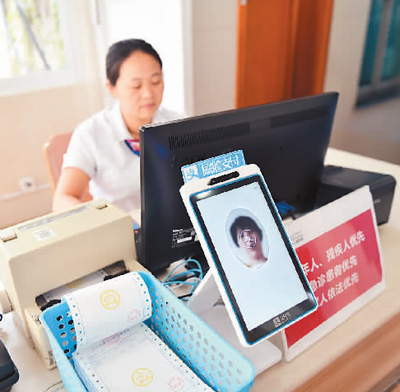


A citizen uses face-scanning payment to pay for her treatment in the Women's and Children's Hospital in Dongyang, Zhejiang Province. (Photo/Bao Kangxuan)
In less than 10 years, mobile payment has become an indispensable part of daily life. According to the "Research report on China mobile payment industry in the first half of 2019" recently published by iiMedia Research, the transaction scale of China's mobile payment reached 166.1 trillion yuan in the first half of 2019. What's more, the number of mobile payment users in China is expected to hit 733 million by the end of this year.
Overseas mobile payments see rapid growth
In the past, outbound travelers had to not only prepare their passports, but also exchange currency when they traveled abroad. However, with the popularization of mobile payment, the payment can be completed anytime and anywhere after leaving the country using a mobile phone, which is much more convenient.
During the recent National holiday, overseas mobile payment ushered in a climatic period. Specifically, in terms of overseas per capita consumption, Zhejiang, Shanghai and Jiangsu ranked the top three, followed by Liaoning, Tianjin and Beijing. The per capita mobile payment consumption of these six provinces and cities exceeded 3,000 yuan.
With the popularization of China's mobile payment, the world is actively embracing mobile payment. More foreign merchants now choose Alipay and WeChat among many other mobile payment platforms. According to statistics, during the National holiday, 300,000 business merchants from 55 countries used Alipay QR codes.
Biotechnology improves payment efficiency
After the rapid development of QR code payment via mobile phone, biotechnology is gradually being introduced into the market in forms such as face-scanning payment. Many shops have already installed machines that can accept payment via facial recognition in a matter of seconds. This move solves the problem of low phone battery or signal.
Many major enterprises have started to accept face-scanning payment. Both Alipay and WeChat are gradually laying out the face-scanning payment market. At the same time, subsidies have also been adopted to help merchants establish facilities and cultivate consumer habits.
In addition, many other biological technologies have gradually been explored and applied to the field of payment, including voiceprint, eye print and palm print. According to experts, voiceprint technology is likely to become the fastest biometrics technology to be applied in financial payment products after fingerprint and face, due to its low hardware cost (an ordinary microphone will do) and difficulty in forgery.
Safety problems of mobile payment
The convenience brought by mobile payment is obvious, but the risks behind it cannot be ignored. We must strengthen the protection in technology, law, and other aspects, to make mobile payments benefit the people instead of causing problems.
Nowadays, mobile payment often needs to be bound with the user's bank card, which gives the payment platform a large amount of bank card information. If personal details or bank card information is leaked, it may endanger the security of the user's property.
Biotechnology has brought not only changes in mobile payment methods but also brings corresponding risks. Using face-scanning payment as an example, its basic principle is to compare the information collected by the terminal hardware with the data stored in the cloud to see if the information is consistent, and then to complete the payment.
Therefore, if the information of the biological database is leaked and used by criminals, a series of severe consequences may occur.
Liu Junhai, a professor at Renmin University of China Law School, said regulators should introduce relevant laws and regulations as soon as possible to strengthen the supervision of face-scanning payment. Besides, enterprises should also self-discipline to protect the security of consumer information and reduce the security risks of face-scanning payment.
 Fire brigade in Shanghai holds group wedding
Fire brigade in Shanghai holds group wedding Tourists enjoy ice sculptures in Datan Town, north China
Tourists enjoy ice sculptures in Datan Town, north China Sunset scenery of Dayan Pagoda in Xi'an
Sunset scenery of Dayan Pagoda in Xi'an Tourists have fun at scenic spot in Nanlong Town, NW China
Tourists have fun at scenic spot in Nanlong Town, NW China Harbin attracts tourists by making best use of ice in winter
Harbin attracts tourists by making best use of ice in winter In pics: FIS Alpine Ski Women's World Cup Slalom
In pics: FIS Alpine Ski Women's World Cup Slalom Black-necked cranes rest at reservoir in Lhunzhub County, Lhasa
Black-necked cranes rest at reservoir in Lhunzhub County, Lhasa China's FAST telescope will be available to foreign scientists in April
China's FAST telescope will be available to foreign scientists in April "She power" plays indispensable role in poverty alleviation
"She power" plays indispensable role in poverty alleviation Top 10 world news events of People's Daily in 2020
Top 10 world news events of People's Daily in 2020 Top 10 China news events of People's Daily in 2020
Top 10 China news events of People's Daily in 2020 Top 10 media buzzwords of 2020
Top 10 media buzzwords of 2020 Year-ender:10 major tourism stories of 2020
Year-ender:10 major tourism stories of 2020 No interference in Venezuelan issues
No interference in Venezuelan issues
 Biz prepares for trade spat
Biz prepares for trade spat
 Broadcasting Continent
Broadcasting Continent Australia wins Chinese CEOs as US loses
Australia wins Chinese CEOs as US loses